
Edu was the name of our guide for our Steel Donkeys bike tour, he was born and raised in Barcelona. He was fantastic. Kathrin, the German girl from the photography tour joined us as well, along with a Russian couple.
Our first stop was in the Gothic Quarters. We had already walked the area extensively, but it was very interesting having a little bit more background knowledge from a local, things you wouldn’t catch or realize the significance of otherwise. Edu pointed out a stone head of a woman attached to the corner of one of the buildings.
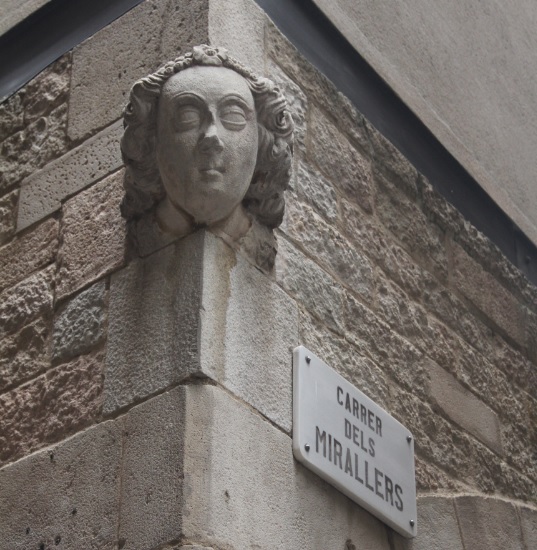
Those heads used to indicate that the building was a brothel. Being a port town, many sailors would come into town seeking out heads such as these. Some of the female heads had snakes for hair like Medusa, or if it were a man’s head, he would have a goatee and devil horns. The buildings themselves were also often painted red, so they were quite recognizable. The businesses were run by the government and the church.
Very few of the heads remain. As the buildings changed ownership, the new owners were quick to remove the sculptures, not wanting their building to be mistaken for a brothel. The one pictured was saved from such fate as a piece of history, a reminder of the past.
As I’ve mentioned, the streets in that neighbourhood are tiny, windy, and hard to navigate (even with a map). Of course, when they were built, the main mode of transportation was by horse drawn carriage. Driving a car down those streets and running into another car would result in a frustrating game of reversing, imagine trying to maneuver horses and a carriage backwards. To prevent this, the streets were made into one ways. There were entrada (enter) signs with a depiction of a horse and carriage indicating which way the street ran, and a salida or exit sign at the end.
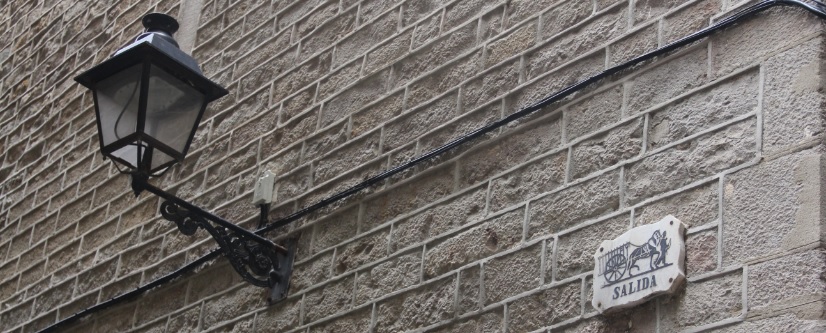
Due to the streets being so narrow, many of the carriages would crash into the the sides of buildings as they turned, damaging the corner of the edifice. If you pay attention, there are many corners where the damage is visible, most extensively lower down where the large wheels would make 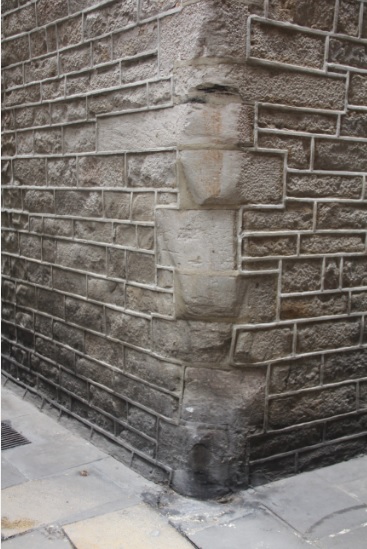 contact. People were unhappy with their homes getting damaged, so they placed large stones at the bases of the street corners so the carriages would hit them instead of their house.
contact. People were unhappy with their homes getting damaged, so they placed large stones at the bases of the street corners so the carriages would hit them instead of their house.
While we were there, we saw some men who were carrying around orange compressed gas cylinders, clanging them as they walked and shouting out into the street. Edu explained that as the buildings are so old, many of them are not connected to any gas lines, so people use propane. The men clang the tanks so that people know they are there and can call down, ordering for one or two to be brought up. It seemed like a sociable, friendly transaction. It reminded me of when we had a milkman when I was a kid, he would take us for rides around the block in his truck.
Next stop was a nut shop that still roasts all of their goods with a wood fired oven. It was called Gispert and had opened in 1851. In front of the shop, embedded into the sidewalk was a plaque presented to the shop by the city. It featured a gold plate with the name of the store, the date it had opened and the date the plaque was awarded. They are to commemorate businesses that have continued to be successful throughout the years and through many generations, as they are often family affairs that are passed down. Surrounding the gold plaque were symbols representing many different trades, such as the lock maker, cobbler and fisherman.
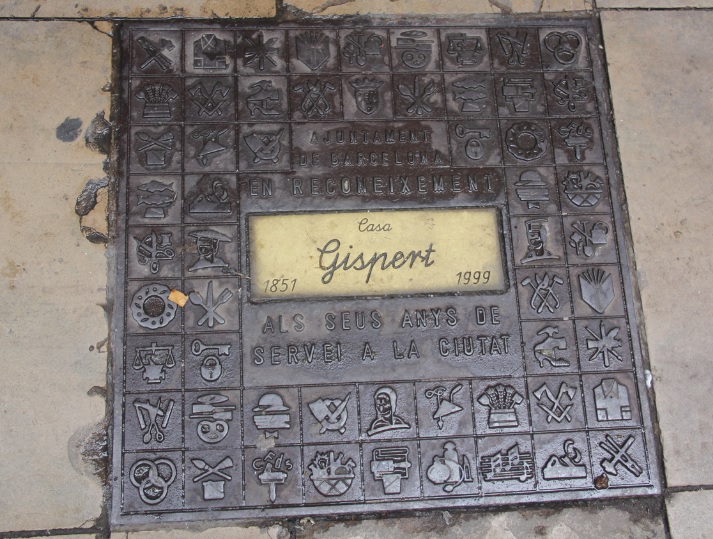
Carrer de la Seca means street of the mint, so naturally this is where an old mint still sits. The windows were barred and there was a large brick 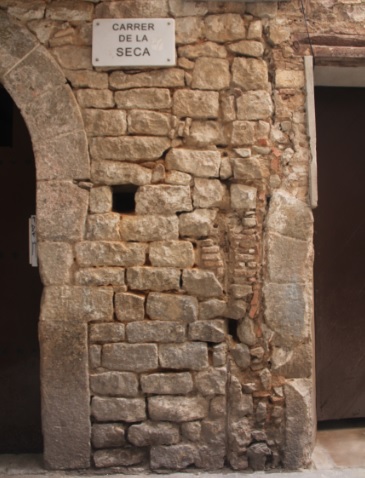 chimney lifting up into the sky. Peseta means little piece in Catalan, and was the unit of currency in Catalonia until 1850. In 1868 the name peseta was used in the new Spanish currency.
chimney lifting up into the sky. Peseta means little piece in Catalan, and was the unit of currency in Catalonia until 1850. In 1868 the name peseta was used in the new Spanish currency.
We continued on into the neighbourhood of El Born. The word born refers to jousting, as one of the main streets in the neighbourhood is where jousting competitions took place. There is a large building that was the local food market from 1876 to 1971. It is unique in its construction as it is mostly made of iron. Many years after the market closed, there was a large debate as to what the building should become. Eventually it was deemed to be a public library. In 2002, shortly after construction commenced, ruins were discovered underneath the original market floor. The library was abandoned and archaeologists set to work preserving the great discovery, believed to have originally been built in the 1700s. What they found was extensive, with many underground tunnels beneath the surrounding city streets.
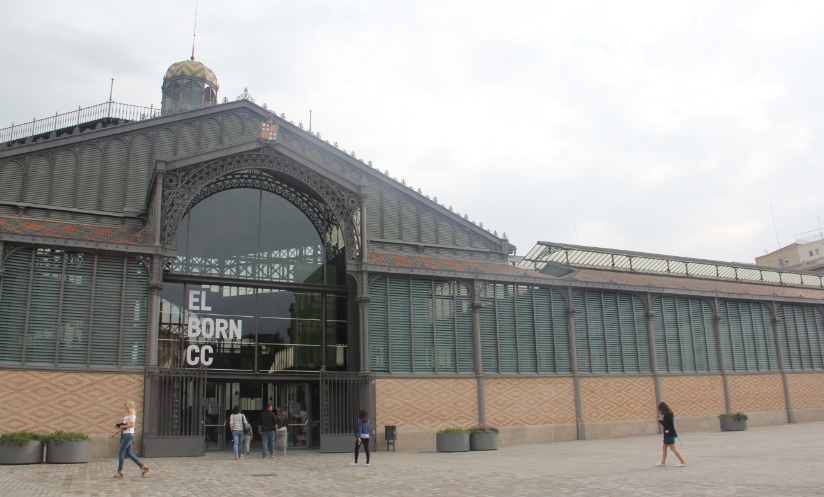
The market officially opened to the public on September 11, 2013. This was 299 years after Barcelona was overcome in a siege, marking the end of Catalonia as an independent state. The building is now known as the El Born Cultural Center where one can get a glimpse of what Barcelona used to look like. The exhibition is one of the few free attractions in the city.
The 1888 World Fair was held in Barcelona; the large arch on Paseo Lluis Companys was used as the main entrance for the exhibit. It was for this event and at this location that Eiffel proposed building his famous structure, but he was turned down and the archway was built instead. Eiffel of course, brought his plans to Paris.
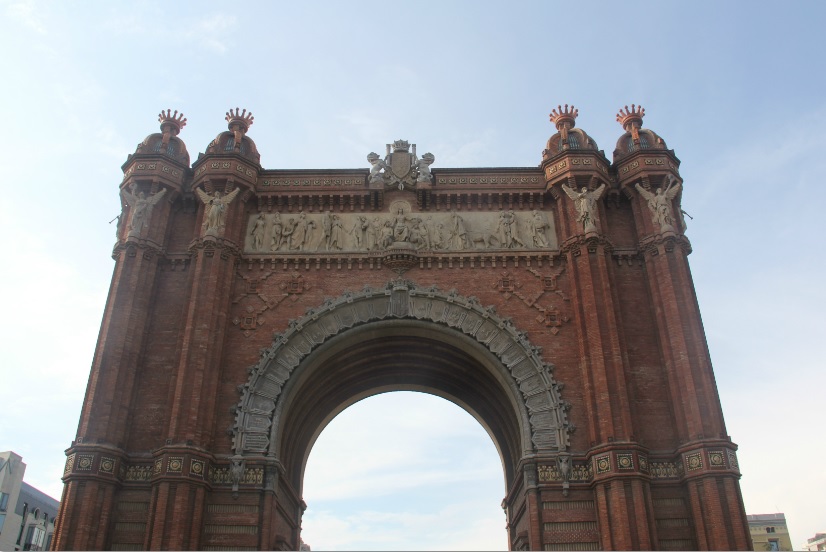
Graffiti is actually illegal within the city, despite it being visible on nearly every street. A person would not go to jail for being caught, they would only receive a fine. It seen on almost every shop door shutters, that are often visible as stores like to close mid day and all day on Sunday. There is one neighbourhood where there was an agreement made with the artists allowing them to tag the shutters. This gave the artists considerably more time to work on their pieces without fear of getting caught.
After watching a city worker remove some graffiti, Edu asked him why he did not remove another piece right beside it. The worker explained that he liked that piece and wanted to leave it.
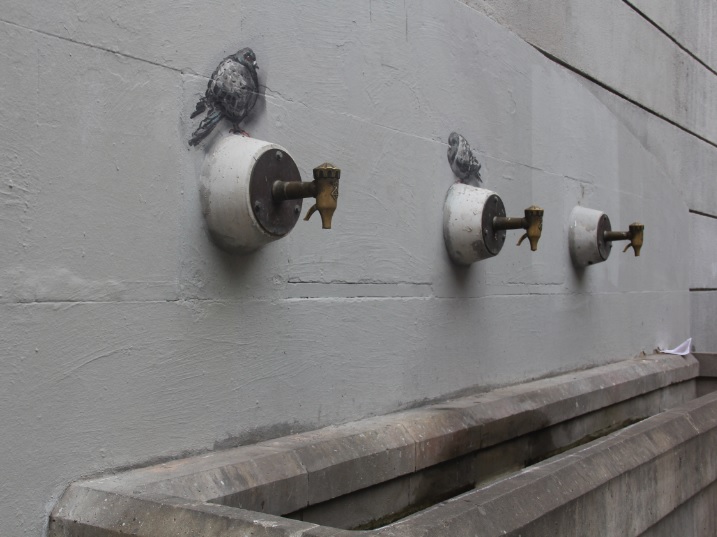
In the mid 19th to 20th century, the city set to work building neighbourhoods in an octagonal grid pattern called Eixample. Ildefons Cerdá designed the streets without corners to allow for better visibility when approaching an intersection, and also to allow air to flow more freely through the city. As a pedestrian, it was kind of annoying walking through the streets. Your journey is extended because you have to constantly zig zag to cross the street.
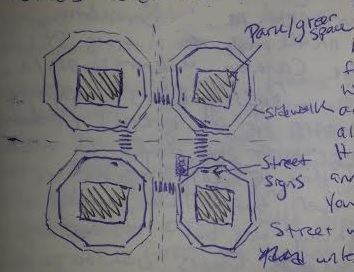 The only street signs they had were small, hard to read plaques that were on the horizontal and/or vertical faces of the buildings. Standing on one of the cut off corners, it was hard to figure out what streets you were on because you’d be searching for these tiny little signs and you’d have to walk around the corner of the building to read it. It seemed like it would be horribly annoying as a driver that is new to the city. It was hard to tell what street was approaching, and you wouldn’t know what street it was unless you turned onto it and were able to spot it while driving. It was odd. I’m glad we didn’t rent a car. Oh, you also would have to watch out for any stupid tourists that would walk out in front of you. Yield to those wielding suitcases.
The only street signs they had were small, hard to read plaques that were on the horizontal and/or vertical faces of the buildings. Standing on one of the cut off corners, it was hard to figure out what streets you were on because you’d be searching for these tiny little signs and you’d have to walk around the corner of the building to read it. It seemed like it would be horribly annoying as a driver that is new to the city. It was hard to tell what street was approaching, and you wouldn’t know what street it was unless you turned onto it and were able to spot it while driving. It was odd. I’m glad we didn’t rent a car. Oh, you also would have to watch out for any stupid tourists that would walk out in front of you. Yield to those wielding suitcases.
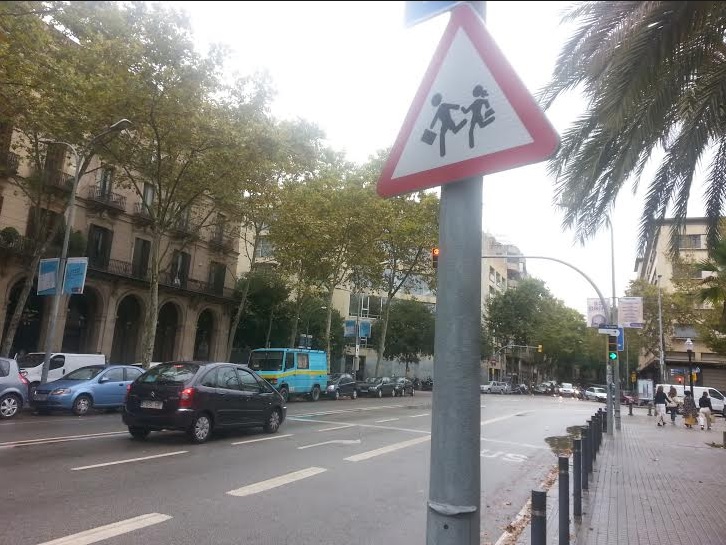
I asked Carlota (our Barcelonian friend) about navigating in the city, and she basically said you just have to learn all the streets and know where you are at all times. Seems odd in a city overrun with tourists. There were some signs that indicated the direction to a larger landmark, like the Plaça Catalunya or Arc de Triomf, but even those did not indicate exactly which street you needed to take, just an arrow blindly leading you a direction.
I love that everyone jay walks here. It’s awesome. You can tell the locals from the tourists by who waits for the light to turn green and who confidently crosses the street when there are no cars coming.
Going back to the octagonal blocks, within them are large parks or green spaces that were designed for people to enjoy. The problem was that it was the homeowners who needed to work together to decide what was to become of the green space and schedule maintenance and other upkeep. Many of the parks became privately accessible through people’s homes, while few remain open to the public with tunnel like streets leading to them. Many of the spaces sit unused. There are currently 8 public parks with plans to open 3 more in the future.
We visited one that had a courtyard with trees interspersed throughout the square. Against the far wall stood an old water tower flanked by two shallow, blue tiled pools. The water tower was in use until the 80’s, and the square is often filled with children running about.
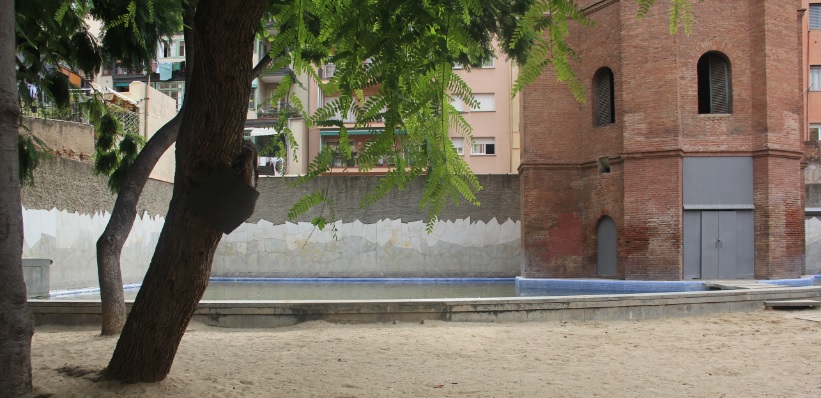
It is legal to ride your bicycle on the sidewalk and there are many bike lanes throughout the city, both separated and sharing the road with vehicles. The bikers seem to coexist quite peacefully with the many pedestrians. Very, very few people wear helmets. The one helmeted rider I can recall right now was on a road bike and looked like he could have been a courier. We were not given helmets on our tour, something I can’t see happening back home.
We stopped at a local market for lunch, I can’t remember the name of it, only that it wasn’t La Baqueria. That market has apparently been taken over by tourists. There were Spanish hams for sale, pigs that had only been fed acorns their whole lives. They go for 3 or 400 euros. This market was the only place we ever had to pay for the toilet, 50 cents. The Russians stocked up on cured meats, they were explaining that you can’t buy them back home anymore.
The Olímpic neighbourhood over near Port Olímpic used to be an industrial area, contaminating the city’s waterfront. A lot of upheaval came with the 1992 Olympic Games, and many of the factories were moved elsewhere in the city and there was a revitalization of the waterfront, creating the vibrant beach life seen today. The water is clear and filled with surfers and other water revelers; there is even a machine that combs the water to keep it clean.
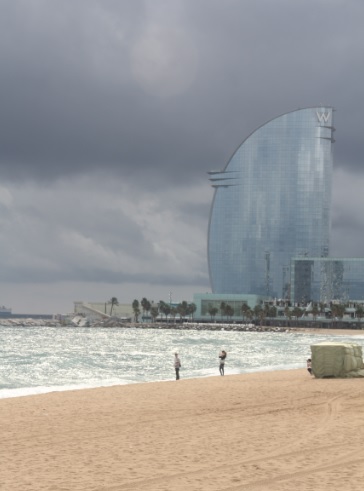
Barceloneta is the adjacent neighbourhood to the west, further down the shore. It is a fisherman’s neighbourhood and is famous for its good food. There is an old cable car built for the 1929 World Fair that still takes tourists up to Montjuïc.
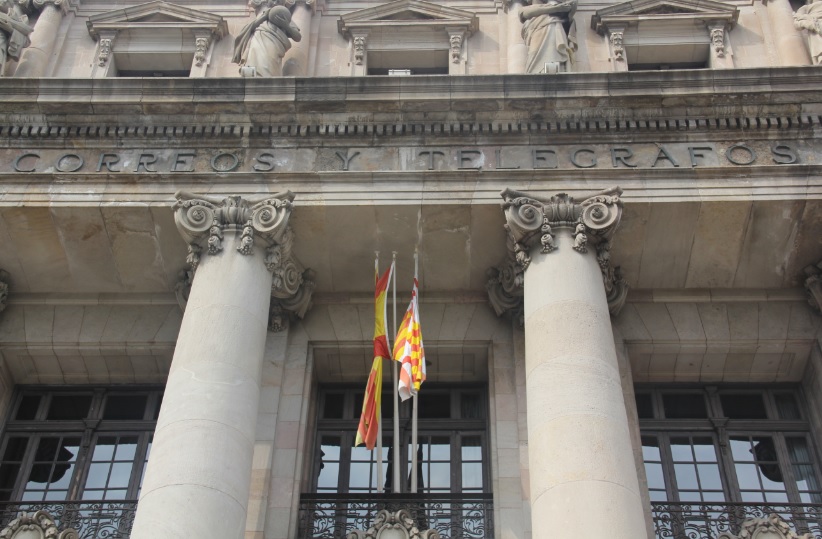
Our last stop was the post office, near to the bike shop. Like many other things here, it is beautiful inside and out. Definitely worth wandering in to send off your postcards.

Parked outside of the post office was a truck branded with Bimbo, a brand of bread. I laughed, nothing like toasted bimbos for breakfast! Bimbo is the word I would use to describe a dumb blonde. Wikipedia says “it is a derogatory slang term for an attractive but unintelligent female.” Kathrin told me that in German, it is a racial slur for black people, referring to them as simple minded. I wonder if the two definitions are related.
I’m breaking this post into two parts, as there is much to write of the rest of the day. So, to be continued…
Amy that was so good to read. Sounds like such a great trip.
LikeLike